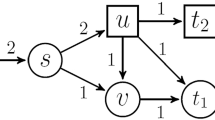Abstract
We consider cut games where players want to cut themselves off from different parts of a network. These games arise when players want to secure themselves from areas of potential infection. For the game-theoretic version of Multiway Cut, we prove that the price of stability is 1, i.e., there exists a Nash equilibrium as good as the centralized optimum. For the game-theoretic version of Multicut, we show that there exists a 2-approximate equilibrium as good as the centralized optimum. We also give poly-time algorithms for finding exact and approximate equilibria in these games.



Similar content being viewed by others
Notes
Recall that a (pure-strategy) Nash equilibrium is a solution where no single player can switch her strategy and become better off, given that the other players keep their strategies fixed.
References
Albers, S., Eilts, S., Even-Dar, E., Mansour, Y., Roditty, L.: On Nash equilibria for a network creation game. In: SODA (2006)
Anshelevich, E., Caskurlu, B.: Exact and approximate equilibria for optimal group network formation. Theor. Comp. Sci. 412(39), 5298–5314 (2011)
Anshelevich, E., Caskurlu, B.: Price of stability in survivable network design. Theory Comput. Syst. 49(1), 98–138 (2011)
Anshelevich, E., Dasgupta, A., Kleinberg, J., Tardos, É., Wexler, T., Roughgarden, T.: The price of stability for network design with fair cost allocation. SIAM J. Comput. 38(4), 1602–1623 (2008)
Anshelevich, E., Dasgupta, A., Tardos, É., Wexler, T.: Near-optimal network design with selfish agents. Theory Comput. 4, 77–109 (2008)
Aspnes, J., Chang, K., Yampolskiy, A.: Innoculation strategies for victims of viruses and the sum-of-squares problem. J. Comput. Syst. Sci. 72(6), 1077–1093 (2006)
Bhalgat, A., Chakraborty, T., Khanna, S.: Approximating pure Nash equilibrium in cut, party affiliation and satisfiability games. In: ACM Conference on Electronic Commerce (EC 2010)
Calinescu, G., Karloff, H., Rabani, Y.: An improved approximation algorithm for multiway cut. J. Comput. Syst. Sci. 60(3), 564–574 (2000)
Cardinal, J., Hoefer, M.: Non-cooperative facility location and covering games. Theor. Comp. Sci. 411(16–18), 1855–1876 (2010)
Chen, H., Roughgarden, T.: Network design with weighted players. Theory Comput. Syst. 45(2), 302–324 (2009)
Chen, H., Roughgarden, T., Valiant, G.: Designing networks with good equilibria. In: SODA (2008)
Christodoulou, G., Mirrokni, V.S., Sidiropoulos, A.: Convergence and approximation in potential games. In: STACS (2006)
Engelberg, R., Könemann, J., Leonardi, S., Naor, J.: Cut problems in graphs with a budget constraint. J. Discrete Algorithms 5(2) (2007)
Epstein, A., Feldman, M., Mansour, Y.: Strong equilibrium in cost sharing connection games. Games Econ. Behav. 67(1), 51–68 (2009)
Fabrikant, A., Luthra, A., Maneva, E., Papadimitriou, S., Shenker, S.: On a network creation game. In: PODC (2003)
Fabrikant, A., Papadimitriou, C.H., Talwar, K.: The complexity of pure Nash equilibria. In: STOC (2004)
Fiat, A., Kaplan, H., Levy, M., Olonetsky, S., Shabo, R.: On the price of stability for designing undirected networks with fair cost allocations. In: Proceedings of ICALP 2006, pp. 608–618 (2006)
Gourves, L., Monnot, J.: On strong equilibria in the max cut game. In: WINE (2009)
Hamilton, S.N., Miller, W.L., Ott, A., Saydjari, O.S.: Challenges in applying game theory to the domain of information warfare. In: 4th Information Survivability Workshop (ISW-2001/2002). Vancouver, Canada (2002)
Hoefer, M.: Cost sharing and clustering under distributed competition. Ph.D. Thesis, Universitat Konstanz (2007)
Hoefer, M.: Non-cooperative tree creation. Algorithmica 53(1), 104–131 (2009)
Hoefer, M.: Strategic cooperation in cost sharing games. In: Proc. 6th Intl. Workshop on Internet & Network Economics (WINE 2010). LNCS, vol. 6484 (2010)
Hoefer, M., Krysta, P.: Geometric network design with selfish agents. In: COCOON 2005. Combinatorics Conference (COCOON 2005). Lecture Notes in Computer Science, vol. 3595, pp. 167–178 (2005)
Jackson, M.: A survey of models of network formation: stability and efficiency. In: Demange, G., Wooders, M. (eds.) Group Formation in Economics: Networks, Clubs and Coalitions. Cambridge Univ. Press, Cambridge (2005)
Karger, D.R., Klein, P., Stein, C., Thorup, M., Young, N.E.: Rounding algorithms for a geometric embedding of minimum multiway cut. Math. Oper. Res. 29(3), 436–461 (2004)
Kearns, M., Ortiz, L.: Algorithms for interdependent security games. In: Advances in Neural Information Processing Systems, vol. 16. MIT Press, Cambridge (2004)
Kunreuther, H., Heal, G.: Interdependent security. J. Risk Uncertain. (Special Issue on Terrorist Risks) (2003)
Leskovec, J., Krause, A., Guestrin, C., Faloutsos, C., VanBriesen, J., Glance, N.: Cost-effective outbreak detection in networks. In: ACM SIGKDD International Conference on Knowledge Discovery and Data Mining (KDD) (2007)
Mavronicolas, M., Michael, L., Papadopoulou, V.G., Philippou, A., Spirakis, P.G.: The price of defense. In: 31st International Symposium on Mathematical Foundations of Computer Science (2006)
Monderer, D., Shapley, L.: Potential games. Games Econ. Behav. 14, 124–143 (1996)
Syverson, P.F.: A different look at secure distributed computation. In: IEEE Computer Security Foundations Workshop (CSFW 10), June 1997
Author information
Authors and Affiliations
Corresponding author
Additional information
A preliminary version of this paper appeared in WAOA 2010.
This work was supported in part by NSF grants CCF-0914782 and CNS-1017932.
Rights and permissions
About this article
Cite this article
Anshelevich, E., Caskurlu, B. & Hate, A. Strategic Multiway Cut and Multicut Games. Theory Comput Syst 52, 200–220 (2013). https://doi.org/10.1007/s00224-011-9380-1
Published:
Issue Date:
DOI: https://doi.org/10.1007/s00224-011-9380-1




